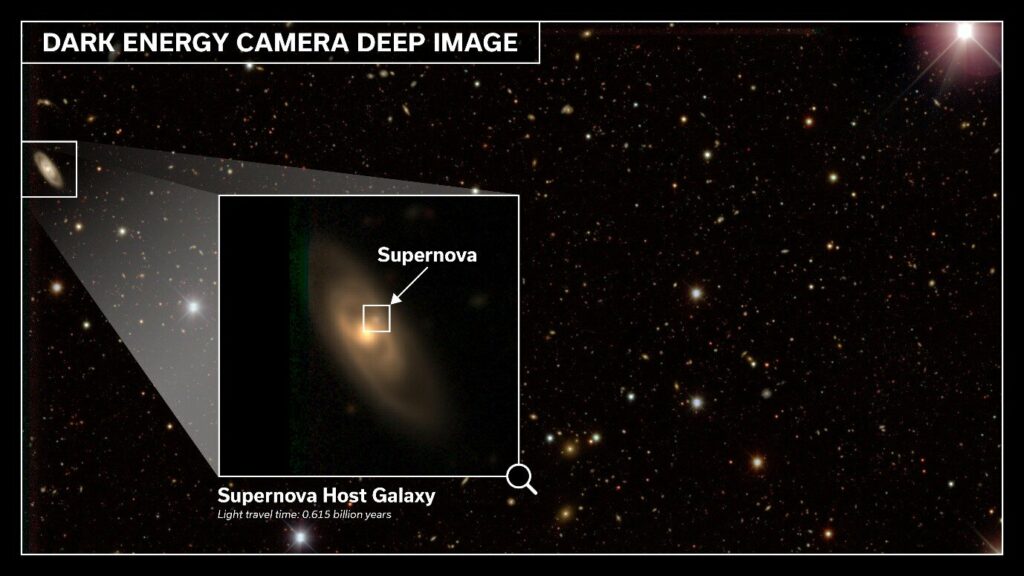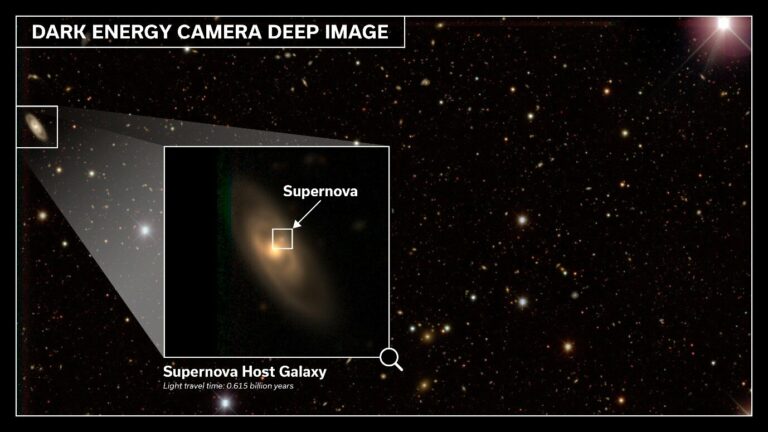New Supernova Observations Unveil Insights into Universe Expansion after a Decade-long Search for Dark Energy
A groundbreaking study that challenges our current understanding of the universe has been conducted by researchers at Swinburne University of Technology. The study, which has been published on the arXiv preprint server, is a result of the collaborative efforts of over 400 astrophysicists, astronomers, and cosmologists from more than 25 institutions.
Over a span of six years and 758 nights, scientists involved in the Dark Energy Survey (DES) collected data to investigate the nature of dark energy and measure the rate of expansion of the universe. The findings of the study suggest that the density of dark energy in the universe may have varied over time, presenting a new and complex theory.

Dr. Anais Möller, a member of the team from Swinburne University of Technology’s Centre for Astrophysics and Supercomputing, expressed pride in the team’s achievements and emphasized the significance of collaboration and hard work in making scientific progress. The thorough analysis conducted by the team has significantly reduced uncertainties and demonstrated the capabilities of the Dark Energy Survey. Dr. Möller also highlighted the development of pioneering methods, including the use of machine learning to select supernovae for the survey.
The discovery of the accelerating expansion of the universe, attributed to the presence of dark energy, was a revolutionary breakthrough made by astrophysicists in 1998. This finding, which was based on observations of type 1a supernovae, earned the Nobel Prize in Physics in 2011. Despite the initial expectation that gravity would cause the universe’s expansion to slow down, the discovery revealed a different reality.
Now, a quarter of a century after the initial discovery, the Dark Energy Survey represents the culmination of ten years’ worth of research conducted by scientists from around the world. These dedicated researchers meticulously analyzed over 1,500 supernovas, utilizing the most stringent constraints on the expansion of the universe ever achieved. This remarkable survey stands as the largest utilization of type 1a supernovae to date, providing invaluable insights into the elusive nature of dark energy across vast cosmic timescales.
The resulting findings align harmoniously with the prevailing cosmological model, which posits an accelerated expansion of the universe. However, while these outcomes are highly significant, they do not definitively exclude the possibility of a more intricate model. Dr. Moller, an esteemed scientist, affirms, “There is still an abundance of knowledge to be gained regarding dark energy. Nevertheless, this analysis can be regarded as the benchmark in supernova cosmology for the foreseeable future.” Dr. Moller further emphasizes that this analysis introduces pioneering methodologies that will shape the next generation of surveys, propelling scientific progress forward. With great anticipation, he looks forward to unraveling more of the enigma surrounding dark energy in the coming decade.
Pioneering a new approach
The novel study introduced a fresh approach to utilizing photometry, employing an unprecedented four filters, in order to detect, categorize, and analyze the light curves of supernovae. Dr. Möller devised this methodology to identify type 1a supernovae by employing modern machine learning techniques.
Dr. Möller expresses her enthusiasm for witnessing this groundbreaking technology harness the capabilities of extensive astronomical surveys. She highlights that not only are we now able to acquire a greater number of type 1a supernovae compared to previous methods, but we have also conducted thorough testing to ensure precision measurements on the fundamental physics of our universe.
This technique relies on data obtained from type 1a supernovae, which occur when a highly dense dead star, known as a white dwarf, reaches a critical mass and undergoes a cataclysmic explosion. Since the critical mass is nearly identical for all white dwarfs, all type 1a supernovae possess approximately the same intrinsic brightness, with any remaining variations being able to be calibrated. Consequently, when astrophysicists compare the apparent brightness of two type 1a supernovae as observed from Earth, they can determine their relative distances from us.
Astrophysicists trace the history of cosmic expansion by studying large samples of supernovae spanning various distances. For each supernova, they combine its distance with a measurement of its redshift, which indicates the speed at which it is moving away from Earth due to the universe’s expansion. This historical data enables them to ascertain whether the density of dark energy has remained constant or undergone changes over time.
The results indicate that w = –0.80 +/- 0.18 when considering supernovae alone. However, when combined with complementary data from the European Space Agency’s Planck telescope, w converges to –1 within the error margins. To reach a definitive conclusion, scientists will require additional data obtained through a new survey.
The DES scientists employed sophisticated machine-learning methods to assist in the categorization of supernovae. From the vast dataset of approximately two million galaxies observed from afar, DES identified several thousand supernovae. Ultimately, researchers selected 1,499 type 1a supernovae with exceptional data quality, resulting in the most extensive and comprehensive supernova sample ever compiled from a single telescope. Back in 1998, Nobel-winning astronomers relied on a mere 52 supernovae to establish the accelerating expansion of the universe.
This article is republished from PhysORG under a Creative Commons license. Read the original article.
Do not forget to share your opinion with us to provide you with the best posts !




0 Comments